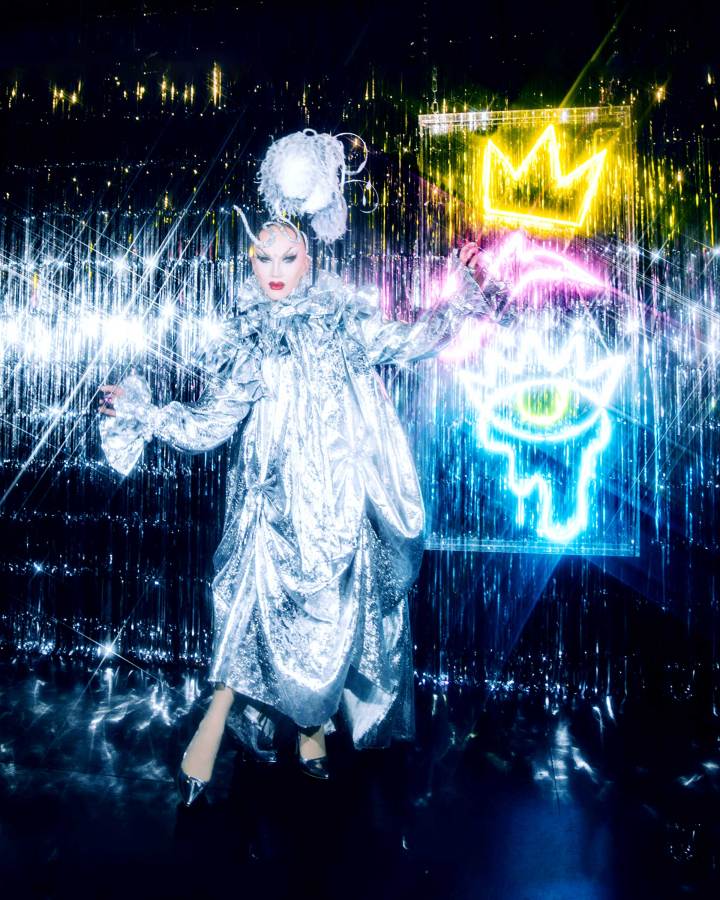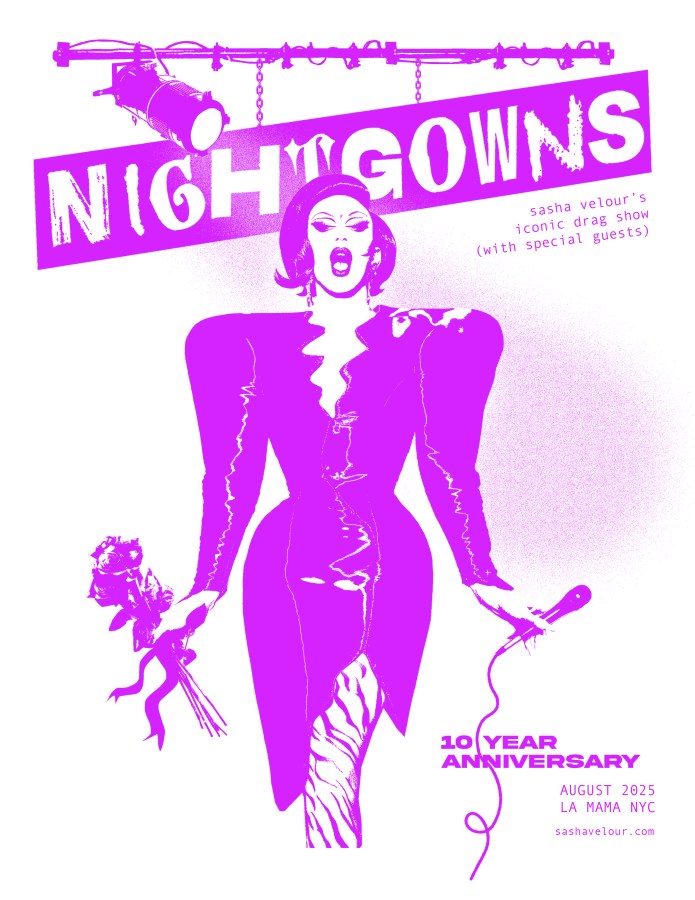When Sasha Velour started NightGowns, her now beloved New York drag show, she was three and a half years into her career. Still a baby queen by her own description, she was having trouble getting booked elsewhere; Brooklyn drag was always quirky, but many of her opportunities early on involved competitions where she couldn’t always be her purest self. But when now-defunct Brooklyn venue Bizarre Bar offered her an opportunity in 2015 to create a show of her own, she jumped at the chance. Now, countless accolades, television shows, theatrical performances, illustrations, and even a book later, NightGowns is still at the heart of Sasha Velour’s life. And it was a key motivator for winning RuPaul’s Drag Race all those years ago.
In celebration of the show’s 10-year anniversary, there will be a seven-show-run of NightGowns at La MaMa, a renowned Off-Off-Broadway theatre in New York’s East Village, beginning August 27. La MaMa was once home to drag legends like Divine and Ethyl Eichelberger. This week Sasha Velour, the NightGowns family of drag artists, and special guests will take to the stage in all of their own glitter and glory, ever a reminder that drag is an artform.
Autostraddle spoke to Sasha Velour about the 10th anniversary of NightGowns, the role of the show in times of upheaval, and why she keeps coming back to it.

Do you see NightGowns as a baby, as a project, as a mission statement, or another combination of experiences?
I love that. It is so tempting to call all our projects our baby. I have seen it grow up. It had growing pains. I feel like it’s reached some kind of maturity, as far as a nightlife event can. Now I’m convincing myself it is a baby, because it has this huge life beyond me. I think it grew in a way I could not have expected. I don’t know that I’ve shaped it that consciously. To survive as a nightlife show for 10 years, you have to keep adapting. I think the consistent thing has been trying to put on a great show for the audience that feels like it’s saying something a little bit different about drag than people are hearing elsewhere. I started the show when drag was booming in Brooklyn certainly. I hadn’t entered the national arena or international arena for drag yet, but doing so helped open my eyes even more to what the missing pieces of the puzzle were. And I’ve always been interested in how we can highlight the missing pieces from this conversation about drag. Because there’s always more to be said about drag, or at least I’ve built my life on that.
Can you talk a bit more about how you see NightGowns responding to the political climate now and over the past 10 years?
It’s always been a place of joy. Even when people bring heartbreaking drag numbers that make everyone cry, there’s still a culture of joy I feel pervades the space. That’s the kind of magic I don’t even totally understand. Like, how can you do art that is so heart wrenching, and then as soon as it’s over, all you feel is happiness? Maybe it’s the joy of watching someone succeed at expressing themselves in such a bold way, the freedom to say things that are painful, is a kind of release that brings joy, so that certainly feels like it is needed. Maybe that’s the escapist pleasure, but it certainly has a political undertone when people are being so honest through their artwork. Since we left Bizarre Bar [NightGowns’ first location] and started being able to charge tickets, that’s allowed us to use the raffle — that was always a part of NightGowns just so we could walk away not empty-handed as performers — as this community organizing tool. In the last three years, we’ve raised over $80,000 for direct mutual aid, going to Gaza, going to immigrants, especially queer immigrants in New York and in the country, for legal battles with name changes, for unhoused trans people in our community who need safe spaces. That’s been such a part of NightGowns’ mission recently, to have the queer joy of seeing art, and then also make it easy and fun to share our resources and help our community. That’s the history that inspires us all. I think it’s clearly written into drag shows that they’re meant to be engaged in community organizing to some degree. This is our solution for now. Who knows what more will be required of us? But we’ll be ready.
Given the government stance on drag currently, what does it mean to you to consistently do NightGowns and to offer performers a space where drag is respected as an art form?
I’m proud of it. It’s the thing I’ve done in my time as a drag queen that really feels like contributing to the legacy of this art that I love so much, that has given me everything to be able to share a spotlight and create this platform where people can feel proud of their work and proud to be a drag artist and like they’ve contributed something that’s going to reach around the world. When I travel, people tell me they’ve watched NightGowns numbers, and usually they have one favorite that’s a performance of mine, and then another favorite that’s someone completely different, someone who’s not touring the world. To bring those voices, those performances, into the conversation, feels like such a huge achievement, and that’s what drag is all about, the way that we give each other this royal platform.
What role do you see NightGowns having had when you look at your drag career now?
It’s still my only regular booking in New York, for various reasons. If you want some dependable work in drag, no matter what level you are at, you better be producing it yourself. That’s what I have learned in 10+ years in this business, and I hope that NightGowns continues to be a model for other overambitious drag performers to do the same.
There’s nothing as satisfying as running a drag show. You learn so much about this art from having to do all those annoying behind-the-scenes tasks, having to do that leadership of employing however many people it takes to put on a show. I learned almost everything that I know about drag from NightGowns. I’ve always approached it with the spirit of experimentation, and it’s been the space I go to try things —plenty of failed experiments at NightGowns, but always something learned along the way that has stayed with me. I found my voice as a host at NightGowns, and that’s what allowed me to go on television and talk about drag with confidence. Maybe the false confidence of a baby queen, but it’s continued to be the space where I figure out what I think drag is here for us to say. From the very beginning, I always had these scripts. When you’re in drag hosting a show, everyone has to listen to you, so my philosophy was, I better say something worth listening to every time I get on this microphone. I have this archive now of all the grand statements I’ve made at NightGowns over the years. I feel like they reflect their time and where I was at, but that everyone’s numbers at NightGowns have, too. Drag shows are this place where at best you’re experimenting, figuring out who you are, and changing who you are to adapt to the time and to reach new heights. The conversations we have backstage as people in this industry together, learning from each other, spilling tea about managers and venues and the way the culture has changed and stayed completely the same all these years, that is a sacred part of drag. I wouldn’t be the drag queen I am without it.
What makes you keep coming back to NightGowns, with all of your successes?
I feel like I have to do it, like it is my responsibility. All these blessings and I wouldn’t give back? That is so wrong. It’s also what I want, what I went on Drag Race to do. What I wanted to do the whole time was to have NightGowns live and be known and be the best of the best —the best from my drag family, that have always been amazing, and the best from all over the world that I could never have dreamed of agreeing to come to NightGowns. Because of the interest and knowledge of this show, I can pay people better than ever. I do pay the [known from] television and the local artists the exact same amount, which is very satisfying. It’s the vision of drag I’ve been pursuing since I first started painting my glitter lip and shaving my head. It feels like this is what it’s all for. NightGowns is my drag family and my home, even more than Brooklyn drag specifically. Like many drag performers, I’m actually quite introverted, and getting to know people backstage at a show is my comfort zone, more than going out and having conversations at the loud club. It’s thrilling with the show to see the way Brooklyn drag has changed, and meeting the kids who consider me mother or grandmother, to get to witness this generational change in the drag world, which happens so fast, that also establishes the sense of pride.
What are your plans for the future of NightGowns?
I’ve given up on planning. I know it will just come to me. I think I want it to run for another 10 years. I still can’t let go of the dream of traveling around the world, and people always are calling on me to do that. I haven’t quite figured out the logistics yet, and we’ve tried a couple of times. But there’s also something so divine about it being this New York show that people have to get themselves to the city to come witness or take part in so whatever happens, as long as people know the name NightGowns and know that it’s where you come to see the good drag, I’ll be happy.









